Ordered 15 March 1928 Commissioned 27 July 1931 Construction started 1 August 1928 Length 175 m Beam 18 m | Namesake Exeter Laid down 1 August 1928 Launched 18 July 1929 Draft 5.2 m | |
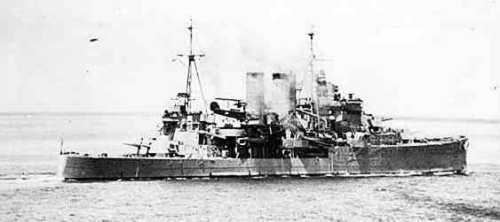 | ||
Hms exeter 68
HMS Exeter was the second and last York-class heavy cruiser built for the Royal Navy during the late 1920s. Aside from a temporary deployment with the Mediterranean Fleet during the Abyssinia Crisis of 1935–36, she spent the bulk of the 1930s assigned to the Atlantic Fleet or the North America and West Indies Station. When World War II began in September 1939, the ship was assigned to patrol South American waters against German commerce raiders. Exeter was one of three British cruisers that fought the German pocket battleship Admiral Graf Spee later that year in the Battle of the River Plate. She was extensively damaged during the battle and was under repair for over a year.
Contents
- Hms exeter 68
- Design and description
- Modifications
- Construction and career
- Battle of the River Plate
- First Battle of the Java Sea
- Second Battle of the Java Sea
- Wreck site
- References

After her repairs were completed, the ship spent most of 1941 on convoy escort duties before she was transferred to the Far East after the start of the Pacific War in December. Exeter was generally tasked with escorting convoys to and from Singapore during the Malayan Campaign and continued on those duties in early February 1942 as the Japanese prepared to invade the Dutch East Indies. Later that month, she was assigned to the Striking Force of the joint American-British-Dutch-Australian Command and took on a more active role in the defence of the Dutch islands. The culmination of this was her participation in the Battle of the Java Sea later in the month as the Allies attempted to intercept Japanese invasion convoys. Exeter was crippled early in the battle and did not play much of a role as she was forced to withdraw. Two days later, she attempted to escape inbound Japanese forces, but was intercepted and sunk by Japanese ships at the beginning of March in the Second Battle of the Java Sea.
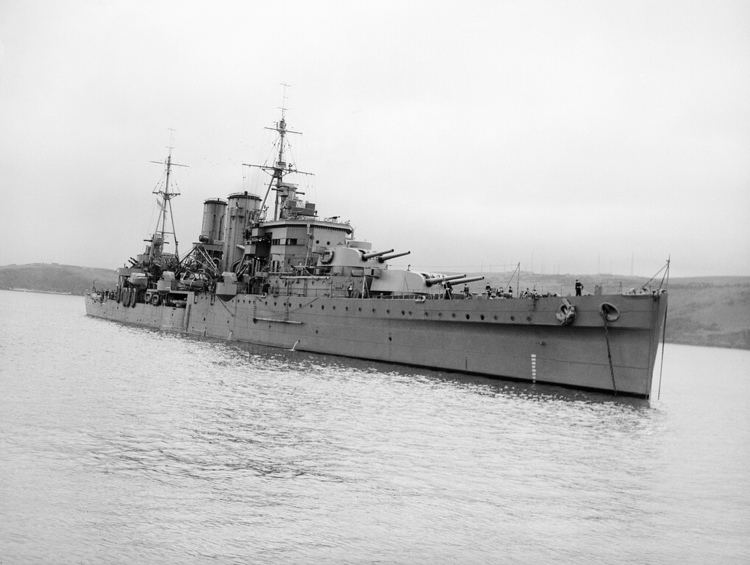
Most of her crew survived the sinking and were rescued by the Japanese. About a quarter of them died during captivity. Her wreck was discovered in early 2007 and by 2016 had been destroyed by illegal salvagers.
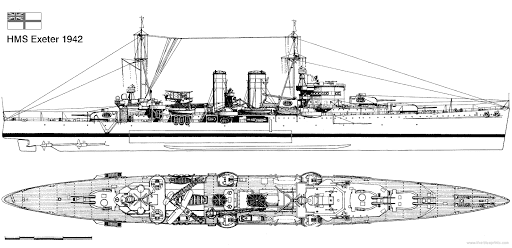
Design and description
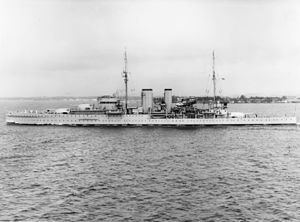
Exeter was ordered two years after her sister ship York and her design incorporated improvements in the light of experience with the latter. Her beam was increased by one foot (30 cm) to cater for increases in topweight, and the boiler uptakes were trunked backwards from the boiler rooms, allowing for straight funnels further removed from the bridge rather than the raked funnels necessary in York to ensure adequate dispersal of the flue gasses. As the eight-inch (203 mm) gun turrets had proved not strong enough to accommodate the aircraft catapult originally intended, Exeter was given a pair of fixed catapults angled out from amidships in a 'V' shape, with the associated crane placed to starboard. Consequently, the bridge was lowered (that of York being tall to give a view over the intended aircraft), and was of a streamlined, enclosed design that was incorporated into later cruisers.

Exeter was slightly lighter than expected and displaced 8,390 long tons (8,520 t) at standard load and 10,620 long tons (10,790 t) at deep load. The ship had an overall length of 575 feet 1 inch (175.3 m), a beam of 58 feet (17.7 m) and a draught of 20 feet 3 inches (6.2 m). She was powered by four Parsons geared steam turbine sets, each driving one shaft, which developed a total of 80,000 shaft horsepower (60,000 kW) and gave a maximum speed of 32 knots (59 km/h; 37 mph). Steam for the turbines was provided by eight Admiralty 3-drum boilers. The ship could carry 1,900 long tons (1,930 t) of fuel oil which gave her a range of 10,000 nautical miles (18,520 km; 11,510 mi) at 14 knots (26 km/h; 16 mph). The ship's complement was 628 officers and ratings.
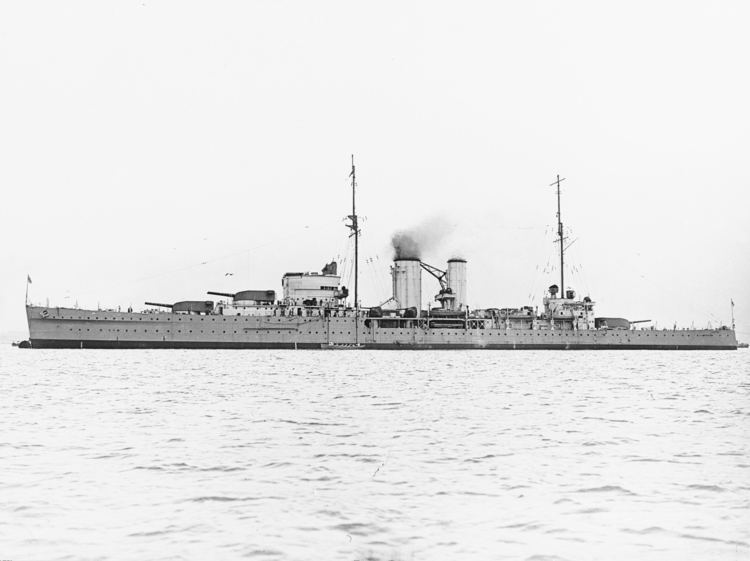
Exeter mounted six BL eight-inch Mk VIII guns in three twin turrets. The turrets were designated 'A', 'B' and 'Y' from front to rear. Their secondary armament consisted of four QF four-inch (102 mm) Mk V anti-aircraft (AA) guns in single mounts. They also mounted two single two-pounder (40 mm) light AA guns ("pom-poms"). The Yorks carried two triple torpedo tube above-water mounts for 21-inch (533 mm) torpedoes.
The York-class cruisers lacked a full-length waterline armour belt. The sides of Exeter's boiler and engine rooms and the sides of the magazines were protected by 3 inches (76 mm) of armour. The transverse bulkheads at the end of her machinery rooms were 3.5 inches (89 mm) thick. The top of the magazines were protected by 5.5 inches (140 mm) of armour and their ends were 4.375 inches (111 mm) thick. The lower deck over the machinery spaces and steering gear had a thickness of 1.5 inches (38 mm).
Modifications
In 1932, Exeter had her side plating extended to enclose her open main deck as far back as the fore funnel. During that same refit, her pair of fixed catapults were finally installed for her embarked Fairey IIIF floatplanes. In 1934–35, two quadruple mounts for Vickers 0.5 in (12.7 mm) AA machineguns replaced the pair of two-pounder "pom-poms" originally installed.
While under repair in 1940–41 after her battle with the Admiral Graf Spee, the navy decided to upgrade her armament and fire-control systems. The bridge was rebuilt and enlarged to accommodate a second High-Angle Control System aft of the Director-Control Tower (DCT) on top of the bridge, her single four-inch AA guns were replaced with twin-gun mounts for Mark XVI guns of the same calibre and a pair of octuple mounts for 40 mm "pom-poms" were added abreast the aft superstructure. Enclosures ("tubs") for single 20 mm Oerlikon guns were added to the roof of both 'B' and 'Y' turrets. The pole masts were replaced by stronger tripod masts because the Type 279 early-warning radar had separate transmitting and receiving aerials, one at each masthead. In addition, a Type 284 fire-control radar was fitted to the DCT.
Construction and career
Exeter, the fourth ship of her name to serve in the Royal Navy, was laid down on 1 August 1928, launched on 18 July 1929 and completed on 27 July 1931. The ship was then assigned to the 2nd Cruiser Squadron of the Atlantic Fleet, where she served between 1931 and 1933. In 1934 she was assigned to the America and West Indies Station and remained there, aside from a temporary deployment to the Mediterranean during the Abyssinian crisis of 1935–36, until 1939.
Battle of the River Plate
At the outbreak of the Second World War, she formed part of the South American Division with the heavy cruiser Cumberland, under Commodore Henry Harwood. The ship, commanded by Captain Frederick Bell, was assigned to Force G to hunt for German commerce raiders off the eastern coast of South America on 6 October 1939. Three months later, Harwood ordered Exeter and the light cruiser Achilles to rendezvous with his own Ajax off the mouth of the River Plate, while Cumberland covered the Falkland Islands. The two other ships arrived on 12 December and Admiral Graf Spee spotted Exeter the following morning.
Captain Hans Langsdorff decided to engage the British and closed at full speed. Following British doctrine on how to engage ships like Admiral Graf Spee, Exeter operated as a division on her own, Achilles and Ajax as the other, to split the fire of the German ship. They were only partially successful as the ship concentrated her main armament of six 283-millimetre (11.1 in) guns on Exeter and her secondary armament of eight 150-millimetre (5.9 in) guns on the light cruisers. Langsdorff opened fire at Exeter at 06:18 with high-explosive shells and she returned fire two minutes later at a range of 18,700 yards (17,100 m). The German ship straddled the British cruiser with her third salvo; splinters from the near misses killed the crew of the starboard torpedo tubes and damaged both seaplanes. After eight salvos from Exeter, Admiral Graf Spee scored a direct hit on 'B' turret that knocked it out of action and splinters from the hit killed all of the bridge personnel except three. Bell, wounded in the face, transferred to the aft conning position to continue the battle. His ship was hit twice more shortly afterwards, but her powerplant was not damaged and she remained seaworthy, although her aircraft had to be jettisoned.
At 06:30, Langsdorff switched his fire to the light cruisers, but only inflicted splinter damage on them before some of Exeter's torpedoes forced him to turn away at 06:37 to evade them. Her second torpedo attack at 06:43 was also unsuccessful. In the meantime, Langsdorff had switched his main guns back to the heavy cruiser and scored several more hits. They knocked out 'A' turret, started a fire amidships that damaged the ship's fire-control and navigation circuits, and caused a 7° list with flooding. She remained in action until flooding disabled the machinery for 'Y' turret at 07:30. At 11:07, Bell informed Harwood that Exeter had one eight-inch and a four-inch gun available in local control and that she could make 18 knots (33 km/h; 21 mph). He ordered Bell to head to the Falklands for repair.
Exeter was hit by a total of seven 283 mm shells that killed 61 of her crew were and wounded another 23. After all Exeter's guns had been put out of action but she was still seaworthy, Bell planned to collide with the enemy, saying "I'm going to ram the --------. It will be the end of us but it will sink him too". In return the ship had hit Admiral Graf Spee three times; one shell penetrated her main armour belt and narrowly missed detonating in one of her engine rooms, but the most important one disabled her oil-purification equipment. Without it, the ship was unlikely to be able to reach Germany. Several days later, unable to be repaired and apparently confronted by powerful Royal Navy reinforcements, Admiral Graf Spee was scuttled in Montevideo harbour.
Exeter made for Port Stanley for emergency repairs which took until January 1940. She was repaired and modernised at Devonport Dockyard between February 1940 and March 1941; Captain W.N.T. Beckett relieved Bell on 12 December 1940. On 10 March 1941, the day Exeter was due to be re-commissioned, Beckett died at Saltash Hospital from complications resulting from surgery related to injuries received earlier in his career. His replacement was Captain Oliver Gordon. On returning to the fleet, she was engaged on escort duty for Atlantic convoys, including the escort of Convoy WS-8B to the Middle East during the chase for the German battleship Bismarck. After the start of the Pacific War in December 1941, the ship was transferred to the Far East.
Upon her arrival at Singapore on 13 January 1942, Exeter was assigned to the ABDACOM naval force that was intended to defend the Dutch East Indies (Indonesia) from Japanese invasion. She spent the first several weeks of February escorting convoys in the East Indies. On 13 February, Allied reconnaissance aircraft spotted Japanese invasion convoys north of Bangka Island and the new commander of ABDA naval forces, Vice Admiral Conrad Helfrich of the Royal Netherlands Navy, was ordered to assemble the Allied Striking Force of Exeter and three Dutch and one Australian light cruisers at Oosthaven on the morning of 14 February. Escorted by six American and three Dutch destroyers, the force departed that afternoon. The Dutch Rear Admiral Karel Doorman, commanding the force, took his ships through the Gaspar Strait and then northwest towards Bangka Island. While passing through the strait, the Dutch destroyer Van Ghent struck a rock in poor visibility and another Dutch destroyer was tasked to take off her crew. The Japanese spotted the Allied ships around 08:00 and repeatedly attacked them. The first was a group of seven Nakajima B5N "Kate" torpedo bombers from the light carrier Ryūjō that attacked Exeter with bombs around 10:30. The blast from a near miss badly damaged her Walrus, but the ship was only damaged by splinters. They were followed shortly afterwards by a group of 23 Mitsubishi G3M "Nell" bombers from the Genzan Air Group that inflicted no damage as they dropped their bombs from high altitude. Another group of six B5Ns attacked without effect at 11:30.
The repeated aerial attacks persuaded Doorman that further progress was unwise in the face of Japanese aerial supremacy and he ordered his ships to reverse course and head for Tanjung Priok at 12:42. The attacks continued as 27 G3Ms of the Mihoro Air Group then bombed from high altitude. Seven more B5Ns attacked fruitlessly at 14:30; a half-dozen more followed an hour later. The final attack was made by 17 Mitsubishi G4M "Betty" bombers of the Kanoya Air Group shortly before dark. The Japanese attacks were almost entirely ineffectual, with no ship reporting anything more than splinter damage. In return Allied anti-aircraft fire was moderately effective with most of the attacking bombers damaged by shell splinters. In addition one G4M crashed while attempting to land and another was badly damaged upon landing.
First Battle of the Java Sea
On 25 February, Helfrich ordered all available warships to join Doorman's Eastern Striking Force at Surabaya. Exeter and the Australian cruiser Perth, escorted by three British destroyers, Jupiter, Encounter, and Electra, set sail at once, leaving behind one Australian cruiser and two destroyers that were short of fuel. After they had arrived the following day, Doorman's entire force of five cruisers and nine destroyers departed Surabaya at 18:30 to patrol off Eastern Java in hopes of intercepting the oncoming invasion convoy which had been spotted earlier that morning. The Japanese were further north than he anticipated and his ships found nothing. His own ships were located at 09:35 on the following morning, 27 February, and were continuously tracked by the Japanese. Doorman ordered a return to Surabaya at 10:30 and his ships were attacked by eight bombers from the Kanoya Air Group at 14:37. They claimed to have made two hits on Jupiter, but actually missed the British destroyer. Just as his leading ships were entering harbour, he received reports of enemy ships 90 miles (140 km) to the north and Doorman ordered his ships to turn about to intercept them.
Aware of Doorman's movements, the Japanese commander, Rear Admiral Takeo Takagi, detached the convoy's two escorting destroyer flotillas, each consisting of a light cruiser and seven destroyers, to intercept the Allied ships in conjunction with his own pair of heavy cruisers, (Nachi and Haguro), which were escorted by a pair of destroyers. His heavy cruisers opened fire at long range at 15:47 with little effect. The light cruisers and destroyers closed to ranges between 13,000 and 15,000 yards (12,000 and 14,000 m) and began firing Type 93 "Long Lance" torpedoes beginning at 16:03. All of these torpedoes failed to damage their targets, although one torpedo hit Exeter and failed to detonate at 16:35. Three minutes later, Haguro changed the course of the battle when one of her shells penetrated the British ship's starboard aft twin four-inch gun mount before detonating in the forward boiler room, knocking six of her boilers off-line and killing 14 of her crew. The ship sheered out of line to avoid another torpedo and slowed, followed by all of the trailing cruisers. Perth laid a smoke screen to protect Exeter and the Allied ships sorted themselves into separate groups as they attempted to disengage. Exeter was escorted by one Dutch and all three British destroyers in one group and the other cruisers and the American destroyers formed the other group. The Japanese did not initially press their pursuit as they maneuvered to use their torpedoes against the crippled Exeter, which could only make 5 knots (9.3 km/h; 5.8 mph), and her escorts.
The Japanese began launching torpedoes beginning at 17:20 at ranges of 10,000 to 18,500 yards (9,100 to 16,900 m), but they all missed. For some reason, two Japanese destroyers continued to close before firing their torpedoes at 6,500 yards (5,900 m) and Encounter and Electra pulled out of line to counter-attack. They engaged Asagumo and Minegumo at close range as they closed. Asagumo was damaged by Electra, but the Japanese ship sank the British destroyer at 17:46. In the meantime, Exeter continued south to Surabaya, escorted by Encounter and the Dutch destroyer Witte de With. Doorman's repeated, unsuccessful, and ultimately fatal, attempts to reach the transports concentrated the Japanese on the task of protecting the transports and allowed the damaged British cruiser to reach harbour.
Second Battle of the Java Sea
The following day, after making temporary repairs and refuelling, Exeter, escorted by Encounter and the American destroyer Pope, was ordered to sail to Colombo, Ceylon, via the Sunda Strait. They departed on the evening of 28 February, but were intercepted by the Japanese heavy cruisers Nachi, Haguro, Myōkō and Ashigara and the destroyers Akebono, Inazuma, Yamakaze and Kawakaze on the morning of 1 March. About 08:00, the British ships spotted two of the Japanese cruisers, one of which launched its spotting floatplanes. Two others were seen closing in, and both launched their aircraft before opening fire at about 09:30. The Allied ships laid smoke and turned away to the east with the Japanese to their north and south. Exeter was able to reach a speed of 26 knots (48 km/h; 30 mph) before the first hit on her again detonated in a boiler room and knocked out all power around 11:20. The Japanese destroyers closed in and fired a total of 18 torpedoes, which made a number of hits. Two of those from the destroyer Inazuma were claimed as hits and Exeter quickly capsized and sank. Encounter and Pope were also lost; Pope temporarily survived the initial melee, only to be sunk by B5Ns a few hours later.
The Japanese rescued 652 of Exeter's crew, including her captain, who became prisoners of war. Of these men, 152 died in captivity.
Wreck site
The wreck was located and positively identified in February 2007, lying in Indonesian waters at a depth of about 200 feet (61 m), 90 miles (140 km) north-west of Bawean Island – some 60 miles (97 km) from the sinking position given by Gordon after the war. Her wreck had been destroyed by illegal salvagers when an expedition surveyed the site in 2016.
